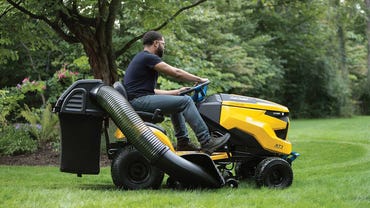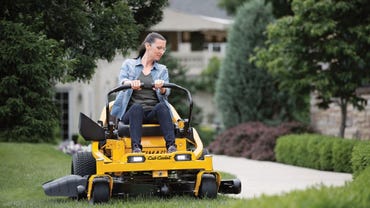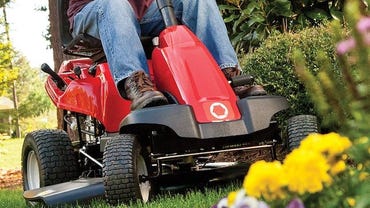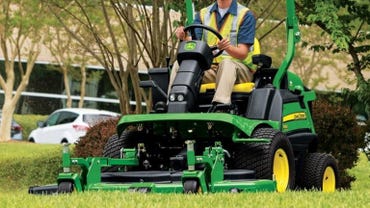The 5 best riding mowers of 2022 | ZDNet
Riding mowers are a popular choice for homeowners, especially if you have a big property to maintain. They have cutting decks measuring from 42 to 72 inches, so you can make short work of everything from typical lawns to large properties like sports complexes and golf courses.
Unlike their push mower counterparts, riding mowers have more features to consider in order to find the right fit for your yard. You can choose either a manual or hydrostatic transmission, so you can “set and forget” your speed or operate your mower like a car. You can even get riding mowers with cruise control or all-wheel drive for better traction.
While gas engines are far more common among riding mowers, there is a wide selection of battery-powered models if you’re looking for a more eco-friendly solution for lawn care. To help you find the perfect fit for your yard and workshop, I’ve rounded up five of the best riding mowers you can buy. I broke down their cutting widths, transmission types, power sources, and other features as well as their price points to help you decide which one best matches your needs and your budget.
Also: The 5 best lawn mowers: Top gas and electric-powered mowers
Husqvarna YTH18542
Best riding mower overall
Cutting width: 42 inches | Transmission: Hydrostatic variable speed | Power source: Gasoline | Mow in reverse: Yes | Mulching/bagger capable: Yes
The Husqvarna YTH18542 snagged the top spot on our list of the best lawn mowers, and it also takes the crown here as the best riding mower you can buy. Personally, I have a slightly older version of this model, and I absolutely adore it.
The 42-inch cutting deck has two sets of blades for more even and consistent cuts, and you can fit it with a mulching kit or bagger attachment for easier cleanup or to re-feed your lawn with ultra-fine clippings. You can set the cutting height to six different positions to get the best cut all season long, and a deck wash feature lets you hook up a garden hose to clear dried grass clippings to maintain optimum performance.
The hydrostatic transmission works like a car: the harder you push the pedal, the faster you go. Which means using this riding mower is much easier than variable speed manual models. It even has a mow-in-reverse feature that keeps the blades engaged when you back up, making it quick and easy to go over spots you may have missed or navigate tricky areas around garden beds.
It’s also equipped with an 18.5HP Briggs and Stratton engine that’s powerful enough to handle hills, inclines, and even rough terrain. The 16-inch turning radius makes it easy to mow around obstacles like trees, lamp posts, and lawn ornaments, and you can hitch a wagon accessory to the back to haul mulch, potting soil, or tools for other yard work.
Pros:
- Hydrostatic transmission
- Mow-in-reverse feature
- Deck wash
- Narrow turn radius
Cons:
- Bagger and mulching kits sold separately
- Deck is tricky to dismantle for sharpening blades
Cub Cadet XT1 Enduro LT
Best electric riding mower

Cutting width: 42 inches | Transmission: Hydrostatic variable speed with cruise control | Power source: 56V battery | Mow in reverse: Yes | Mulching/bagger capable: Yes
The Cub Cadet XT1 Enduro LT was one of our picks for the best electric lawn mowers, and it’s still the best electric riding mower you can buy. It’s built on the same chassis as the gas-powered XT1, so you’ll get the same durable construction without the hassle of an engine maintenance routine.
The XT1 Enduro LT uses a built-in, 56V battery to power the unit, and it can be charged with a regular wall outlet, so you don’t have to worry about needing a special charger. A full charge will give you about 90 minutes of run time, which is enough to handle lawns up to two acres. When you do need to plug in, it’ll reach 100 percent in about four hours, so you can top up the battery while you take a lunch break or tackle other outdoor chores.
The 42-inch deck uses dual blades for an even, consistent cut and has a mow-in-reverse feature that keeps the blades running while you back up so you can navigate tricky areas or go back over spots you missed. You can adjust the deck to 12 different heights for the perfect cut all season long over almost any terrain. There are even built-in USB ports so you can charge your phone while you mow.
Pros:
- No engine maintenance
- Mows up to two acres on full charge
- USB charging ports
Cons:
- Expensive
- Long charging time
Cub Cadet Ultima ZT1
Best zero turn riding mower

Cutting width: 50 inches | Transmission: Hydrostatic variable speed | Power source: Gasoline | Mow in reverse: Yes | Mulching/bagger capable: yes
The Cub Cadet Ultima ZT1 nabbed our pick for the best zero turn mower you can buy. It’s equipped with a 23 horsepower Kawasaki, twin-cylinder engine, and a hydrostatic transmission for easier operation — and enough power to handle steep inclines and large yards. The frame is made of tubular steel for durability and strength and is painted with a corrosion resistant powder coat to prevent rust and damage from the elements.
The 11-gauge stamped steel deck comes in sizes from as small as 42 inches up to 54 inches to make short work of just about any size lawn, and it can be adjusted to 15 different cutting heights for perfect results all season long. The seat and lap bars are fully adjustable and feature ergonomic designs for more comfortable long-term use, while the seat suspension system provides a smoother ride across rough terrain.
Like the name implies, the zero-inch turn radius means you can pivot in place when you need to, making it easy to maneuver the lawn mower around obstacles like small trees and lawn ornaments or oddly shaped sections of your yard.
Pros:
- Four deck sizes
- Hydrostatic transmission
- Ergonomic seat and lap bars
- Durable, corrosion resistant construction
Cons:
- Very expensive
- Needs a large storage area
- Lap bars have a steep learning curve for driving
Troy-Bilt TB30
Most affordable riding mower

Cutting width: 30 inches | Transmission: Six-speed manual | Power source: Gasoline | Mow in reverse: No | Mulching/bagger capable: Yes
While it’s hard to find a riding mower that can truly be considered “budget-friendly,” the Troy-Bilt TB30 is one of the most affordable models on the market. If you buy directly from Troy-Bilt, it retails for around $1,800, while retailers like Home Depot and Tractor Supply Company sell them for just a hair under $2,000.
It features a 30-inch cutting deck, which is perfect for lawns that hit that rare middle ground of being too big for a push mower to be practical but not quite big enough to justify buying a 42 or 46-inch lawn tractor. The deck is designed to easily transition from a traditional side discharge to mulching grass to make it easy to re-feed your lawn with ultra-fine clippings. It also has a six-speed manual transmission, so you can set the forward or reverse speed that best suits your yard and go.
The body of the mower features a slim, compact design that’s great for garages and tool sheds on the smaller side. Since the engine is mounted on the rear of the lawn mower, you’ll have a better line of sight, which is great for seeing things like sticks and rocks that need to be removed and watching out for pets and children who may be nearby. And just because the engine is smaller doesn’t mean it skimps out on power; with 10.5HP, you’ll be able to pull garden carts, spreaders, sprayers, and other implements to tackle every outdoor chore.
Pros:
- Compact design
- Affordable price compared to other models
- Rear-mounted engine
- Mulching capable
- Six-speed transmission
Cons:
- No mow-in-reverse feature
- Not hydrostatic
John Deere 1570 TerrainCut
Best commercial riding mower

Cutting width: 60 or 72 inches | Transmission: Hydrostatic variable speed with optional AWD and cruise control | Power source: Diesel | Mow in reverse: Not specified | Mulching/bagger capable: Not specified
The John Deere 1570 TerrainCut is a commercial-grade lawn mower designed for handling places like golf courses, sports complexes, and public parks. But if you live in a rural area and have a 5- to 10-acre property to maintain, it can be a powerful asset to have in your workshop.
It’s available only through local dealers or the official John Deere website, and if you go through the official site, you can customize aspects of the 1570 TerrainCut to better suit your needs. You can choose either rear or side discharging decks in either 60- or 72-inch lengths for ideal clipping disbursement and streamlined mowing. The gas tank holds up to 16 gallons (60.6 liters) of diesel fuel, so you can spend more time working and less time refilling your tank.
The 37.4HP engine and hydrostatic drive allow you to operate the TerrainCut like a car, and you can opt for all-wheel drive for better traction across steep or rough terrain. The mower has a “steer from the rear” design, meaning the back two wheels control the direction of the entire unit, which will take some getting used to if you’ve never driven something similar before, especially when driving in reverse.
The deck is stamped from seven-gauge steel and can be adjusted from one to six inches for cutting height, so you can maintain everything from upscale golf courses to grazing pastures and drainage ditches. And while the almost $28,000 price tag puts this mower squarely out of reach of typical homeowners, it’s a worthy investment if you have a landscaping business or need to maintain a very large, rural property.
Pros:
- Two deck sizes
- Hydrostatic drive
- Optional all-wheel drive
- Roll-over protection bar
Cons:
- Outrageously expensive
- Can only be repaired or serviced at official John Deere dealers
- Runs on diesel fuel
What is the best riding mower?
In my opinion, the Husqvarna YTH18542 is the best riding mower you can buy. It has a 42-inch stamped steel deck, dual cutting blades, and a mow-in-reverse feature for maneuvering around tricky areas and obstacles. It also has a hydrostatic transmission which allows you to operate the mower like a car: press the pedal and go, no more messing with levers.
|
Riding mower |
Price |
Cutting width |
Transmission type |
|
Husqvarna YTH18542 |
$2099 |
42 inches |
Hydrostatic variable speed |
|
Cub Cadet XT1 Enduro LT |
$4659 |
42 inches |
Hydrostatic variable speed |
|
Cub Cadet Ultima ZT1 |
$3849 |
Up to 54 inches |
Hydrostatic variable speed |
|
Troy-Bilt TB30B |
$1799 |
30 inches |
Six-speed manual |
|
John Deere 1570 TerrainCut |
$27,995 |
60 or 72 inches |
Hydrostatic variable speed |
Which is the right riding mower for you?
Other than your budget, there are a lot of features and scenarios you have to consider while shopping for a new riding mower. The size of your yard will determine how wide the cutting deck should be, though either a 42 or 46-inch version will be more than enough for most yards.
You can choose either a manual or hydrostatic transmission. A manual model lets you “set and forget” your speed so you can focus, while hydrostatic models operate more like cars, going faster the harder you press the pedal. This makes them more intuitive to operate, but also more expensive.
Zero turn mowers are designed for mowing in oddly-shaped areas or around lots of obstacles like trees, lamp posts, and lawn ornaments. They’re called “zero turn” because they have a zero-inch turn radius; you pivot around either rear wheel for ultra-tight turning.
|
Choose this riding mower… |
If you need… |
|
Husqvarna YTH18542 |
A well-rounded, gas-powered mower for yards up to two acres |
|
Cub Cadet XT1 Enduro LT |
A battery-powered riding mower for eco-friendly lawn care |
|
Cub Cadet Ultima ZT1 |
A zero turn mower for maneuvering around obstacles or tricky areas |
|
Troy-Bilt TB30B |
A compact riding mower for lawns a touch too large for a push mower |
|
John Deere 1570 TerrainCut |
A commercial-grade mower for a landscaping business or large rural property |
How did we choose these riding mowers?
Aside from price, I chose both gas and battery-powered riding mowers to give you a choice in how you handle yard work. Gas-powered models give you better run times and more horsepower, while battery-powered ones save you time and money on engine maintenance and help reduce your carbon footprint.
I also chose a variety of cutting deck widths for handling everything from 1 to 10 acres, including a commercial-grade model for large rural properties and landscaping businesses.
How do you decide which riding mower to buy?
Assuming you have a budget in mind, the first thing you need to do is find out how big your lawn is. You can either find your lot size on your memorandum deeds if you’ve bought your house, or you can check your city’s website to see if you can request lot measurements if you’re renting. If your lot measures about an acre, you’ll be able to use a 30 or 42-inch cutting deck without any issues. For lawns up to two acres, a 42 or 46-inch deck is ideal. And if your lot is over two acres, you can get a mower with up to a 72-inch cutting deck to handle larger areas.
The transmission type is also important. Many newer models have what is known as a hydrostatic drive. This means that they operate similar to how a car drives: you push the pedal and it moves forward or backwards. And the harder you push, the faster you go. This makes it easier to learn how to drive, but that also makes the mower more expensive. More stripped-back models have variable speed manual transmissions, which allow you to “set and forget” your speed so you can focus on paying attention to obstacles and people who may be nearby.
And finally, you’ll want to consider the power source for your new riding mower. Gasoline engines are far more common, but there is now a wider variety of battery-powered models to choose from. The perks of a gas engine are that you’ll get near-infinite run times (as long as you have enough fuel to keep the engine going) and a bit more power for handling steep inclines and rough terrain. The downsides are dealing with exhaust emissions and maintenance that can be a time and money sink. Electric models don’t need engine maintenance, so you save a bit of money in the long run. But they usually have a maximum run time of about an hour, which means that you may have to plan your mowing over several days if you have a larger yard.
How big of a yard do I need for a riding mower?
Riding mowers are best suited for yards measuring one acre or larger. A model with a 42-inch cutting deck is great for mowing up to two acres, so if you have more land than that, you’ll want to spring for a 46, 54, 60, or 72-inch cutting deck.
If you’re right on the threshold, you can get what’s known as a “mini rider.” They usually have compact bodies for easier storage and 30-inch cutting decks to make short work of lawns that are just a touch too large for a push mower.
How long should a riding mower last?
No matter if you choose a gas or battery-powered riding mower, proper maintenance is key to extending the life of your mower. For gas engines, you should change the oil and filters, clean the spark plugs, and sharpen the blades before you mow for the first time in the spring. And you should use fuel treatments like STA-BIL to prevent gas in the tank or in extra jerry cans from going bad from moisture contamination. This prevents build-up of gunk that can ruin your engine, improves engine performance, and gives you a cleaner cut for a healthier lawn.
Electric mowers don’t need engine maintenance, but you should perform thorough inspections at the start of mowing season to check for battery damage, corrosion on battery contacts, damage to the battery housing, and to sharpen the blades. If you do regular maintenance, not only will you save money by avoiding big repairs from worn out parts, you can also expect your riding mower to last 10 years or more. Which is great news, since they can be an expensive investment.
Are there alternative riding mowers worth considering?
Whether you’re shopping at a big name DIY store like Lowe’s, a local hardware store, or an authorized brand dealer, there are tons of options for a new riding mower. You can choose either gas or battery-powered models, cutting deck widths from as small as 30 inches to as wide as six feet.
Here’s a short list of other riding mowers I thought were great choices:
For all the latest Technology News Click Here
For the latest news and updates, follow us on Google News.
